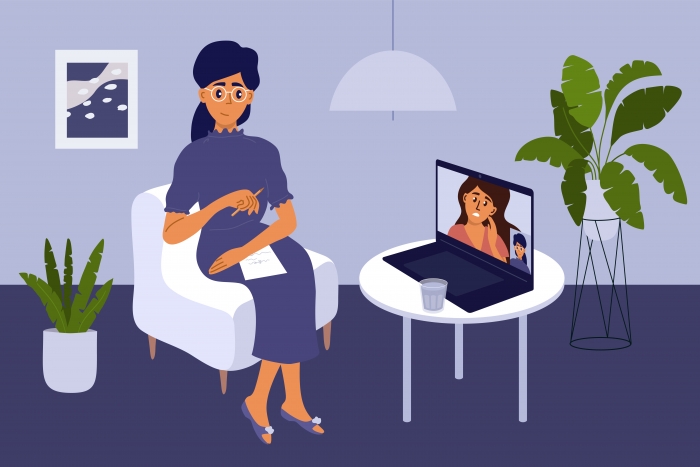By Kristen S. Springer, PhD, coauthor of The Big Book of Exposures
Getting creative with exposures for our patients who present with a range of anxiety, panic, obsessive-compulsive disorder (OCD), and related disorders has always been important. Exposures that are creative tend to be tailored to your specific patient; make the session more enjoyable (for both kids and adults); and can really help you, as the therapist, target the patient’s core fear. Now, more than ever, we have to get creative as the majority of us are doing therapy online. Many of our go-to exposures that were once conducted in our offices simply cannot be done in the same way. This might be for safety reasons (probably not the best time to ask patients to touch door knobs and then their face and mouth), not having in-person sessions (how the heck do you design exposure for patients who are behind a screen and in a location you are unfamiliar with?), and not having access to public places where we would once take our patients (or encourage them to go for homework) to help them face their fears.
So, in the age of telehealth sessions, mask wearing, hand sanitizer, washing, and social distancing, what is an exposure therapist to do? Get (even more!) creative. You might be surprised to hear that you can still do the exposures you used to do, but with a little modification (and hopefully not too much hand sanitizer, sigh).
In fact, you may quickly come to learn that there are some really cool benefits to conducting exposure via Zoom (or any other platform of your choosing). When you are virtually entering into a patient’s home, the opportunities for exposure are endless. But you aren’t restricted to just the patient’s home. Consider asking the patient to venture outside of the home during your session, too. A walk for someone with agoraphobia (hold the safety behaviors, please). Interoceptive exposure exercises (e.g., hyperventilating on purpose, running in place, spinning, etc.) outside in the warmer weather for added intensity. Purposely fumbling over words during a drive-thru order or going through the same drive-thru multiple times in a row for social anxiety fears.
For those who have done out-of-office exposures before with patients, you know the challenges of having to schedule driving time to and from the location and making sure you can get back in time for your next therapy session. Now, we can have patients do exposure from different locations in the same day while you stay in your same office chair and are ready (and on time) for your next appointment.
So, how do you modify exposures during this time? Engage the patient. Ask, “Do you have an idea for exposure that would be most helpful for me to do with you in or near your home? I’d be really curious to hear your ideas.” Patients usually have a really good idea of what they would most benefit from and how you could help. They don’t necessarily need to design the exposure (this may be for more advanced patients), but can offer you suggestions of areas that are challenging for them. Use the patient’s space. Say, “We’ve been working on your urges to refrain from ordering/arranging items, so why don’t you ‘take me with you’ to your bookshelf so we can do an exposure where we put books out of order. Or consider, “We’ve been working on fighting your urges to engage in ritualistic behaviors with the stove, locks, and faucets. Where could we go in your house today to start doing exposure?” Prior to the pandemic, these types of exposures might have been assigned for homework, but now we can do it in real time with our patients in their own space. Make good use of the internet. Conduct Google searches with your patient. This can work if you are using a screen-sharing feature in your telehealth call or you can have the patient do the search while talking to you about what shows up. As an example, for the patient with a snake phobia, you may say, “Let’s start by having you search for pictures of cute snakes, then poisonous snakes, deadly snake accidents, etc.” You can then talk about what the patient sees as well as get the patient to describe the snakes in detail. You can have the patient read or listen to an imaginal exposure script while looking at pictures of snakes. Don’t forget to incorporate video clips from YouTube about snakes as well.
So, until we can be back in the office and back to our normal routines (and maybe you will decide to continue with teletherapy for the long term), think about how you can get (even more!) creative with your exposures.
Kristen S. Springer, PhD, is a licensed clinical psychologist with a private practice in the greater Boston, MA, area. She earned her doctoral degree from the University of Florida; and completed her postdoctoral clinical and research training at the Anxiety Disorders Center, and the Center for Cognitive Behavioral Therapy at the Hartford Hospital Institute of Living in Hartford, CT. She continued working at the Anxiety Disorders Center as a staff psychologist before opening her private practice, where she specializes in the assessment and treatment of obsessive-compulsive disorder (OCD) and anxiety disorders in adolescents and adults. Springer has authored several book chapters and scientific journal articles in the fields of anxiety, hoarding, OCD, and chronic pain.



 2024 Peace Playbook: 3 Tactics to Avoid Clashes with Your Partner
2024 Peace Playbook: 3 Tactics to Avoid Clashes with Your Partner